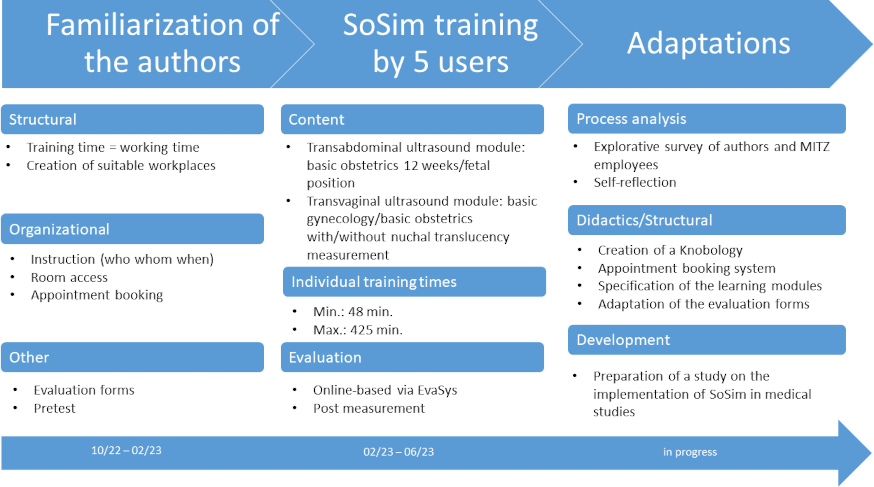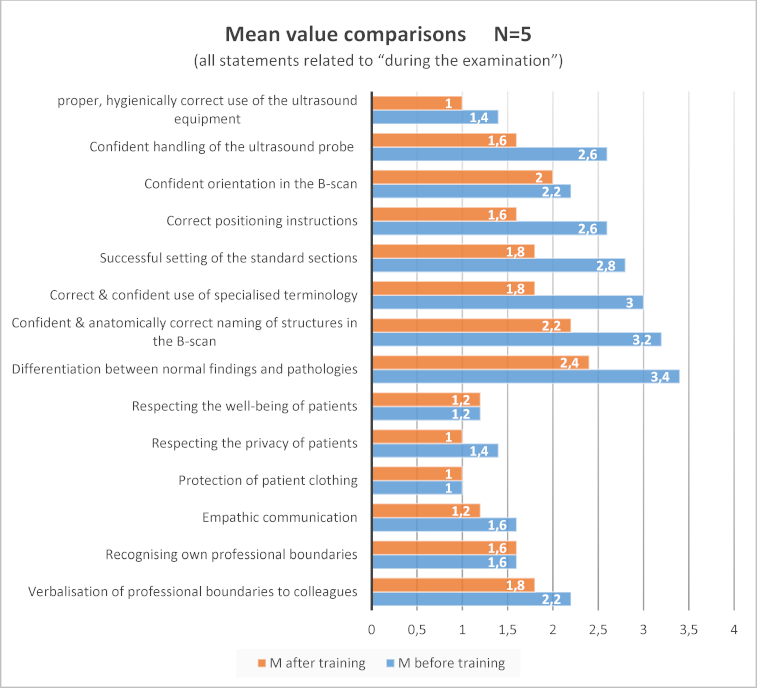Pilot implementation of a sonography simulator in gynecological medical training and continuing education: A practical report
Anne Röhle 1Marie-Christin Willemer 1
Cahir Birdir 2
Katharina Nitzsche 2
1 TUD Dresden University of Technology, Carl Gustav Carus Faculty of Medicine, Institute of Medical Education, Medical Interprofessional Training Centre (MITZ), Dresden, Germany
2 University Hospital Carl Gustav Carus at the Dresden University of Technology, Clinic and Out-patient Department for Obstetrics and Gynecology, Dresden, Germany
Abstract
Objective: In addition to patient consent, learning sonography requires considerable time and personnel resources. To implement patient-friendly and resource-saving ultrasound teaching, a comprehensively equipped sonography simulator (SoSim) was purchased at the Medical Interprofessional Training Centre (MITZ) of the Faculty of Medicine at TU Dresden. In a first step, the SoSim training was trialed in a sample (n=5) in cooperation with the Clinic and Polyclinic for Gynecology and Obstetrics at Dresden University Hospital (GYN). Based on the findings, the aim is to extend the project to University Medicine Dresden.
Description of the project: After creating the necessary structural and organizational conditions, five female GYN trainees trained two defined modules in SoSim on transvaginal and abdominal ultrasound. The evaluation was carried out by online-based evaluation of the participants and process analysis.
Results: The process analysis showed that close supervision of the learners is required and that booking individual appointments is time-consuming. The evaluation of the participants showed a positive mean change in the approval ratings for 11 out of 14 competency-based questions.
Conclusion: Despite the integrated SoSim learning program, support for learners is necessary. By piloting the use of SoSim to teach transvaginal ultrasound as part of gynecological specialist training, University Medicine Dresden is a pioneer in innovative and patient-friendly teaching. The pilot project has laid the foundations for the expansion of the project into other areas.
Keywords
sonography, simulator, feedback, e-Learning, medical education, medical training, skills lab
1. Background
Sonography is firmly integrated into preventive, routine, emergency, and follow-up diagnostics. Standardized and structured training of all medical professionals is therefore essential, while at the same time conserving human, spatial and financial resources [1].
At the Medical Interprofessional Training Centre (MITZ) of the Faculty of Medicine at TU Dresden (MFD), students of medicine, dentistry and midwifery train basic practical skills and communication skills. The MITZ also offers opportunities for further and advanced training.
Since 2015, ultrasound teaching at the MITZ has been successively implemented, expanded and professionalized. During the collaboration with the Clinic and Polyclinic for Gynecology and Obstetrics at Dresden University Hospital (GYN) in the midwifery degree program, points of intersection became clear regarding efforts to ensure resource-conserving, needs-oriented teaching and the bundling of didactic skills. Limitations in current sonography training due to limited space and personnel capacities became apparent in both areas, as well as the need for patient-friendly teaching.
In 2022, the MITZ purchased a fully equipped sonography simulator (SoSim) with the support of the MFD: the SCANTRAINER 7A of Skills Med Germany. In the pilot phase, the SoSim was tested in cooperation with the GYN. Under the technical and didactic supervision of the authors, five young professionals from GYN trained two defined modules on the SoSim over a period of five months and were asked about their subjective appraisal after the training (see figure 1 [Fig. 1]). The aim was to use the pilot phase to identify positive effects in terms of competence gain and to create a spatial and organizational basis for a sustainable and comprehensive use of the SoSim for entire University Medicine Dresden.
Figure 1: Time and content aspects of the project with necessary structural and organizational conditions and adjustments for practical implementation
2. Description of the project
Initially the authors were familiarized with the SoSim, and the necessary structural and organizational conditions were created to adequately support the users learning progress (see figure 1 [Fig. 1]).
As part of the pilot program, all new recruits at the GYN at this point of time trained in transvaginal and transabdominal ultrasound with SoSim at determined and individually agreed training times. Two specific learning modules were defined to be completed during the course (see figure 1 [Fig. 1]). All modules contain a structured learning program with text and video-based learning aids, automatic error correction and audiovisual feedback. The five learners were monitored by means of cloud-based evaluation of the learning outcomes and accompanying self-assessment at a measurement point via online-based evaluation using the EvaSys software [https://www.electricpaper.biz//]. The survey included questions on demographics, previous experience, attitude, self-assessment of competences before and after training on the simulator, questions on general use of the simulator and transfer of learning to the clinic. The 14 competency questions were divided into technical (compliance with hygiene, probe handling, orientation in the B-scan, technical terms, setting standard sections, differentiation between normal and pathological findings), social (positioning, communication) and personal aspects (own limits, stress experience). The questions were answered using a five-point Likert scale from “applies” to “does not apply” (see figure 2 [Fig. 2]).
Figure 2: Mean change in agreement values for items relating to competence before/after SoSim training
0=applies, 4=does not apply
The piloting processes were analyzed and reflected in a circular manner by the authors by means of an exploratory survey of the perspectives of the participating authors and employees at MITZ in individual interviews. For this purpose, observation protocols and text documents were evaluated in the categories organizational-spatial, didactic-content, structural-personal.
3. Results
The process analysis confirmed research findings on self-directed learning to the effect that learners require learning assistance to reflect on their own learning process despite the availability of a comprehensive and transparent learning program with integrated learning management and feedback [2]. As part of the pilot, this was realized by preselecting and controlling the sequence of the learning modules to be completed with additional feedback from the supervising senior physician to enable prompt clinical applicability.
Furthermore, the greatest administrative effort for all those involved was required to coordinate individual appointments.
The response rate for the evaluation of SoSim utilization was 100%. The results for the competency questions in the evaluation of the five GYN career starters are shown in figure 2 [Fig. 2]. The agreement values for the items increased for 11 of 14 questions in comparison before/after the training, while the values remained identical for three questions.
4. Discussion
The results influence the further organization of structural framework conditions, the transfer of the project to other areas as well as the didactic support and education research to be established.
Structural
For an acceptable use by learners, the SoSim-training as part of the overall training concept needs to be integrated into medical working hours, existing curricula, and further education programs [3]. Departments need to provide appropriate resources. In addition to standards for instruction and training specifications, the transfer of the learnt to the patient must be ensured.
To reduce the organizational effort, individual appointment booking for users was established using automated processes and digital booking tools.
Transfer
Due to the positive changes in the approval ratings in the evaluation of SoSim use, the simulator will soon be accessible to medical staff in further training in the specialist areas of internal medicine and anesthesia. The learning modules to be completed will be determined according to learning requirements and clinical applicability. The SoSim will be successively integrated into student training and accompanied by educational research.
Didactic support
Despite the integrated SoSim learning program, a learning assistant is required to pre-select and manage the learning modules. The results of the one-off evaluation indicate a subjective increase in learning. A larger sample with a pre-post design is aimed for significance tests and clear causal relationships.
5. Outlook
A transfer to further areas of education and the gradual implementation of SoSim training for student tutors and students is in planning and will be monitored via a separate study.
Authors’ ORCIDs
- Anne Röhle: [0009-0001-6691-5401]
- Marie-Christin Willemer: [0009-0000-7950-5922]
Competing interests
The authors declare that they have no competing interests.
References
[1] Dietrich CF, Lucius C, Nielsen MB, Burmester E, Westerway SC, Chu CY, Condous G, Cui XW, Dong Y, Harrison G, Koch J, Kraus B, Nolsøe CP, Nayahangan LJ, Pedersen MRV, Saftoiu A, Savitsky E, Blaivas M. The ultrasound use of simulators, current view, and perspectives: Requirements and technical aspects (WFUMB state of the art paper). Endosc Ultrasound. 2023;12(1):38-49. DOI: 10.4103/EUS-D-22-00197[2] Dyrna J, Riedel J, Schulze-Achatz S, Köhler T, editors. Selbstgesteuertes Lernen in der beruflichen Weiterbildung: Ein Handbuch für Theorie und Praxis. Münster, New York: Waxmann Verlag; 2021. DOI: 10.31244/9783830993643
[3] Tolsgaard MG. Assessment and learning of ultrasound skills in Obstetrics & Gynecology. Danish Med J. 2018;65(2):B5445.




